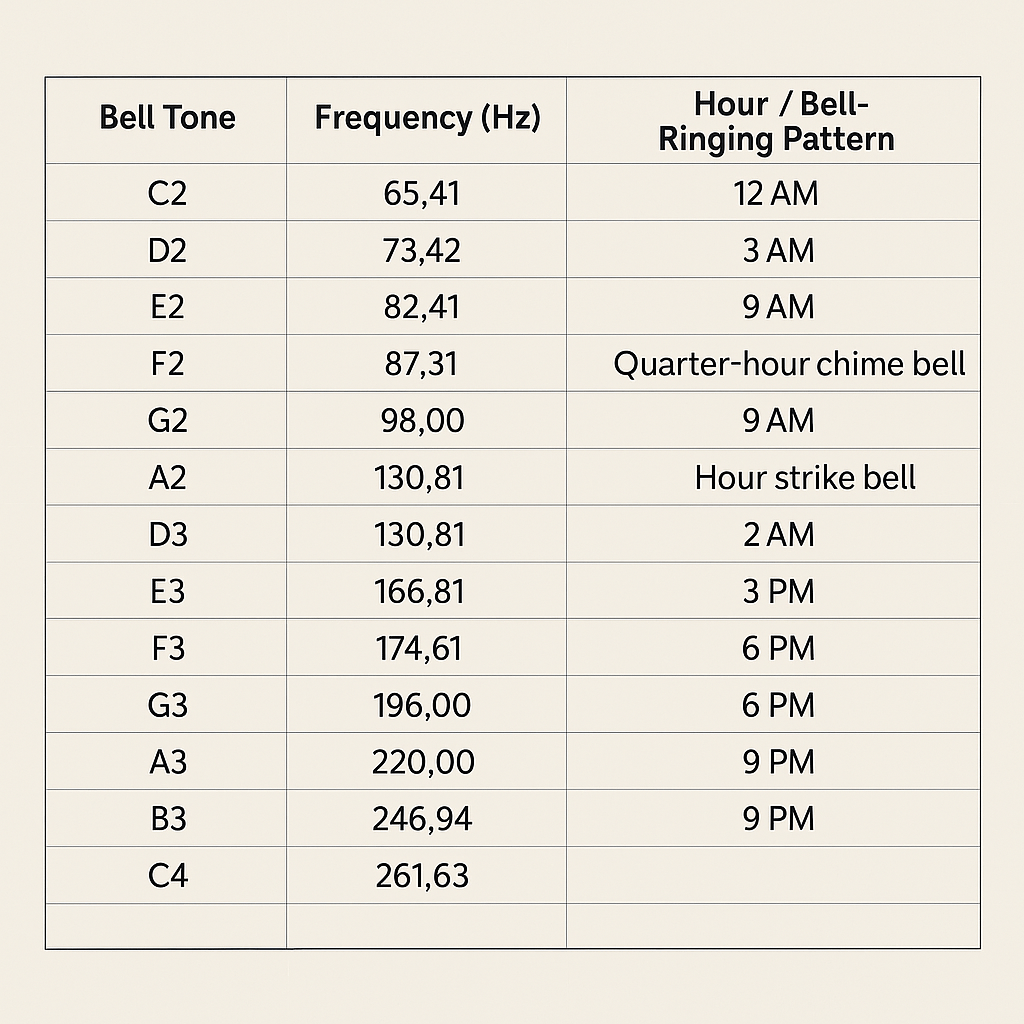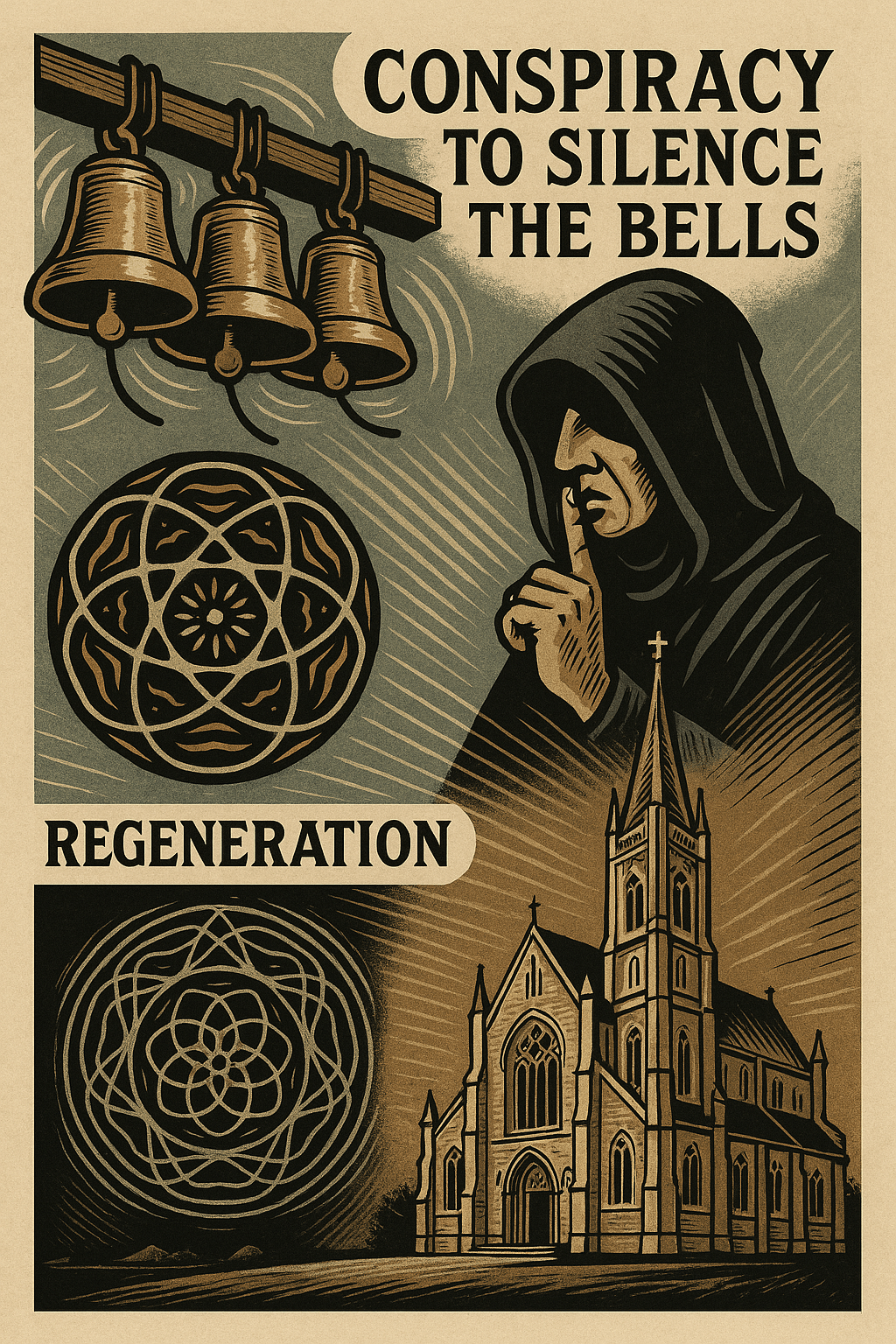Strange paucity of peal bells
A deeply fascinating and underexplored mystery — the decline of peal bells and the silencing of traditional bell-ringing, particularly in churches and cathedrals. When viewed through both historical and arcane lenses, this subject offers several layers of inquiry — technological, cultural, spiritual, and perhaps even conspiratorial.
1. What Are Peal Bells, and Who Used to Make Them?
Traditional Peal Bells:
- Large cast bronze bells tuned to specific notes.
- Arranged in sets (usually 6–12) and rung in mathematical sequence patterns (“change ringing”).
- Found primarily in British churches, cathedrals, and some civic towers.
- Bell Founders (Historically):
- Whitechapel Bell Foundry (London): 1570–2017. Famous for Big Ben, Liberty Bell. Closed in 2017 after 450+ years.
- John Taylor & Co (Loughborough): Still operational, but with significantly reduced output.
- Gillett & Johnston (Croydon): Big in the early 20th century, now virtually inactive.
- Blews & Sons, Warners of Cripplegate, Eijsbouts (Netherlands), and others across Europe.
🔍 Whitechapel’s closure marked a spiritual and industrial turning point. The oldest bell foundry in the world — shuttered just before COVID and global tech acceleration.
2. Why Did the Peal Bell Tradition Decline?
Cultural Disintegration:
- Secularization of society: churches no longer central to daily life.
- Urban noise ordinances: complaints about noise have led many towers to silence or automate bells.
- Lack of ringers: requires a dedicated and trained team, often volunteers.
- Modern clock towers use speakers or recordings, not real bells.
Industrial Decay:
- Few foundries remain; the skills are specialized and disappearing.
- Hand-tuned, cast bronze bells are expensive and take time.
- Cheaper alternatives (steel bells, electronic chimes) dominate.
3. Arcane Possibilities: Was There a Conspiracy to Silence the Bells?
A. Bells as Energy Devices
- Bells produce long-range, low-frequency acoustic energy — used to mark time, summon people, and possibly affect resonant fields in human consciousness.
- Some believe church bells were part of an ancient sonic architecture — like cathedral acoustics and cymatics — designed to entrain communities spiritually.
Could silencing them be a form of spiritual disconnect?
B. Post-War Dematerialization
- After WWI and WWII, many bells were confiscated, melted down for munitions.
- Entire bell traditions (esp. in Eastern Europe) vanished overnight.
- Could bell silencing be part of a symbolic erasure of identity?
C. Acoustic Suppression & EM Dominance
- The age of electronic frequencies has overtaken acoustic traditions.
- Bells were once central broadcast tools — literal sound towers.
- Now replaced by RF, EMF, and Wi-Fi fields — could the removal of resonant bronze frequencies be part of an unspoken energy shift?
D. Bells & Spiritual Resistance
- Bells have long been symbols of warding off evil, calling to prayer, or consecrating sacred time.
- If one wanted to erode the sacred and flatten time into pure productivity, silencing the bells would be a subtle and effective strategy.
4. Who Makes Church Bells Today? (And Who’s Gone?)
Still Active:
- John Taylor & Co (UK)
- Royal Eijsbouts (Netherlands)
- Paccard (France)
- Grassmayr (Austria)
Gone or Defunct:
- Whitechapel Bell Foundry (UK): Closed 2017
- Gillett & Johnston (UK): Only tower clock work now
- Meneeley Bell Co. (USA): Gone since 1952
- Many Eastern European foundries destroyed during WWII or Soviet occupation
Summary: Layers of Decline and Possibility
| Layer | Explanation |
|---|---|
| Cultural | Churches faded from daily centrality; volunteers disappeared |
| Economic | Costly, skilled work; no scalable profit; outsourced or abandoned |
| Technological | Replaced by recordings, loudspeakers, or removed entirely |
| Symbolic/Spiritual | Bells were metaphysical anchors; their silence is a kind of ritual void |
| Conspiratorial | Could be part of broader disconnection from natural rhythms, sacred sound, and group consciousness |
Here’s a detailed list of bell tones, their musical notes, and their corresponding frequencies (Hz) — along with how they traditionally map to the hours and bell-ringing patterns used in timekeeping, especially in church towers, peals, and carillons.
BELL TONE FREQUENCIES – STANDARD WESTERN MUSICAL SCALE
| Note | Frequency (Hz) | Bell Size (approx) | Common Bell Use |
|---|---|---|---|
| C2 | 65.41 | Very large | Hour strikes in large towers |
| D2 | 73.42 | ||
| E2 | 82.41 | ||
| F2 | 87.31 | ||
| G2 | 98.00 | Westminster chime | |
| A2 | 110.00 | ||
| B2 | 123.47 | ||
| C3 | 130.81 | Common lowest peal bell | |
| D3 | 146.83 | ||
| E3 | 164.81 | ||
| F3 | 174.61 | ||
| G3 | 196.00 | Medium-sized peal bell | |
| A3 | 220.00 | ||
| B3 | 246.94 | ||
| C4 | 261.63 | Standard tuning pitch (“middle C”) | Small peal bell |
| D4 | 293.66 | ||
| E4 | 329.63 | ||
| F4 | 349.23 | ||
| G4 | 392.00 | ||
| A4 | 440.00 | Concert pitch reference | |
| B4 | 493.88 |
TIME + BELL STRIKING PATTERNS
1. Hour Strike Bells
- Typically use deep, slow tones (C2–C3 range)
- Struck once for each hour (e.g., 12 strikes at noon)
2. Quarter Hour Chimes
Most famously used in the Westminster Quarters:
| Time | Strike Pattern | Notes (approx) |
|---|---|---|
| 15 minutes | 1 short phrase | G4, C4, D4, E4 |
| 30 minutes | 2 phrases (reversed) | E4, D4, G4, C4 (x2) |
| 45 minutes | 3 phrases | Pattern cycles |
| 60 minutes | Full 4-phrase chime + hour strikes | G4, F4, E4, D4 (full) |
Fun fact: The Westminster sequence is derived from Handel’s “I Know That My Redeemer Liveth”.
Bells and Frequencies in Vibrational / Esoteric Systems
Many believe certain bell tones resonate with:
| Note | Frequency (Hz) | Esoteric Association |
|---|---|---|
| C | ~261 (C4) | Rooting, grounding |
| D | ~294 | Sacral, creativity |
| E | ~329 | Solar plexus, action |
| F | ~349 | Heart chakra, compassion |
| G | ~392 | Throat chakra, expression |
| A | ~440 | Third eye (modern pitch) |
| B | ~493 | Crown, spiritual perception |
Historically, cathedrals and bells were tuned to resonate with local acoustic harmonics, aligning with celestial or seasonal rhythms.
Overlay: Hours, Frequencies, and Harmonic Mapping
| Hour | Traditional Bell Note | Frequency (Hz) | Symbolic Role |
|---|---|---|---|
| 12 AM | C2 | 65.41 | Threshold of night; cosmic silence |
| 3 AM | E2 | 82.41 | Watch of angels; intuition |
| 6 AM | G2 | 98.00 | Dawn call, renewal |
| 9 AM | B2 | 123.47 | Labor, intent |
| 12 PM | C3 | 130.81 | Zenith, balance |
| 3 PM | E3 | 164.81 | Sacrifice, transformation |
| 6 PM | G3 | 196.00 | Evening calm, closing of day |
| 9 PM | B3 | 246.94 | Reflection, prayer, dreams |

